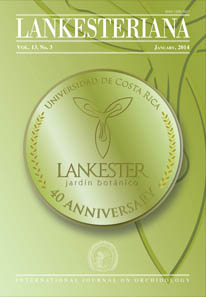OrganIzación espacial y estructura de una población de Ionopsis utricularioides (Orchidaceae) en un área suburbana de Pinar del río, Cuba
DOI:
https://doi.org/10.15517/lank.v13i3.14432Keywords:
micrositio, forófito, clases de vida, plantas agregadas, plantas solitarias, naranjoAbstract
We determined the population structure and some habitat conditions of a Ionopsis utricularioides (Orchidaceae) population in an orange orchard (citrus sinensis, Rutaceae), located in the “La Juanita” farm, Pinar del Río, Cuba. We took into account all the orange trees of the orchard, and located all the individuals of I. utricularioides. The following variables were analyzed: height and diameter of branches in growing orchids, orchid distribution on phorophytes (trunk, branches or twigs), life stage of the orchids (immature or adults), orientation of orchids in the phorophyte, if the plants were solitary or aggregated, and kind of neighbours in the case of the aggregate. Of the 10 trees of c. sinensis, eight trees had orchids of I. utricularioides, with 217 plants. Almost all orchids were observed on the twigs (98.61 %) and none were observed on the trunk of the tree. The number of plants is relatively high in the two stage of life. Most plants of I. utricularioides were found growing aggregate with individuals of the same species, or with other species of vascular epiphytes. This is a stable and mature population. Growing up in aggregation can give competitive advantages to I. utricularioides.Downloads
Download data is not yet available.
Downloads
How to Cite
Gacía González, A., & Riverón Giró, F. (2014). OrganIzación espacial y estructura de una población de Ionopsis utricularioides (Orchidaceae) en un área suburbana de Pinar del río, Cuba. Lankesteriana: International Journal on Orchidology, 13(3). https://doi.org/10.15517/lank.v13i3.14432
Issue
Section
Articles
License
According to the Open Access policy promoted by the University of Costa Rica, all the papers published by Lankesteriana are licensed under the Creative Commons copyright and can be downloaded free of charge. The journal holds copyright and publishing rights under the CC BY-NC-ND 3.0 CR license.
Before the publication of the materials submitted by the author(s) in LANKESTERIANA, the author(s) hereby assign all rights in the article to the Lankester Botanical Garden.








